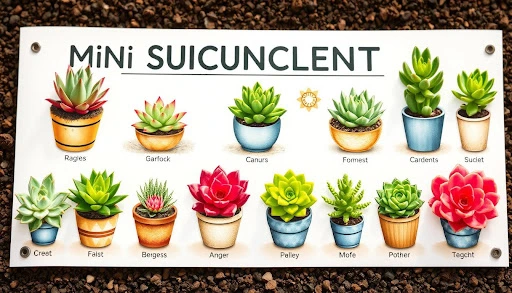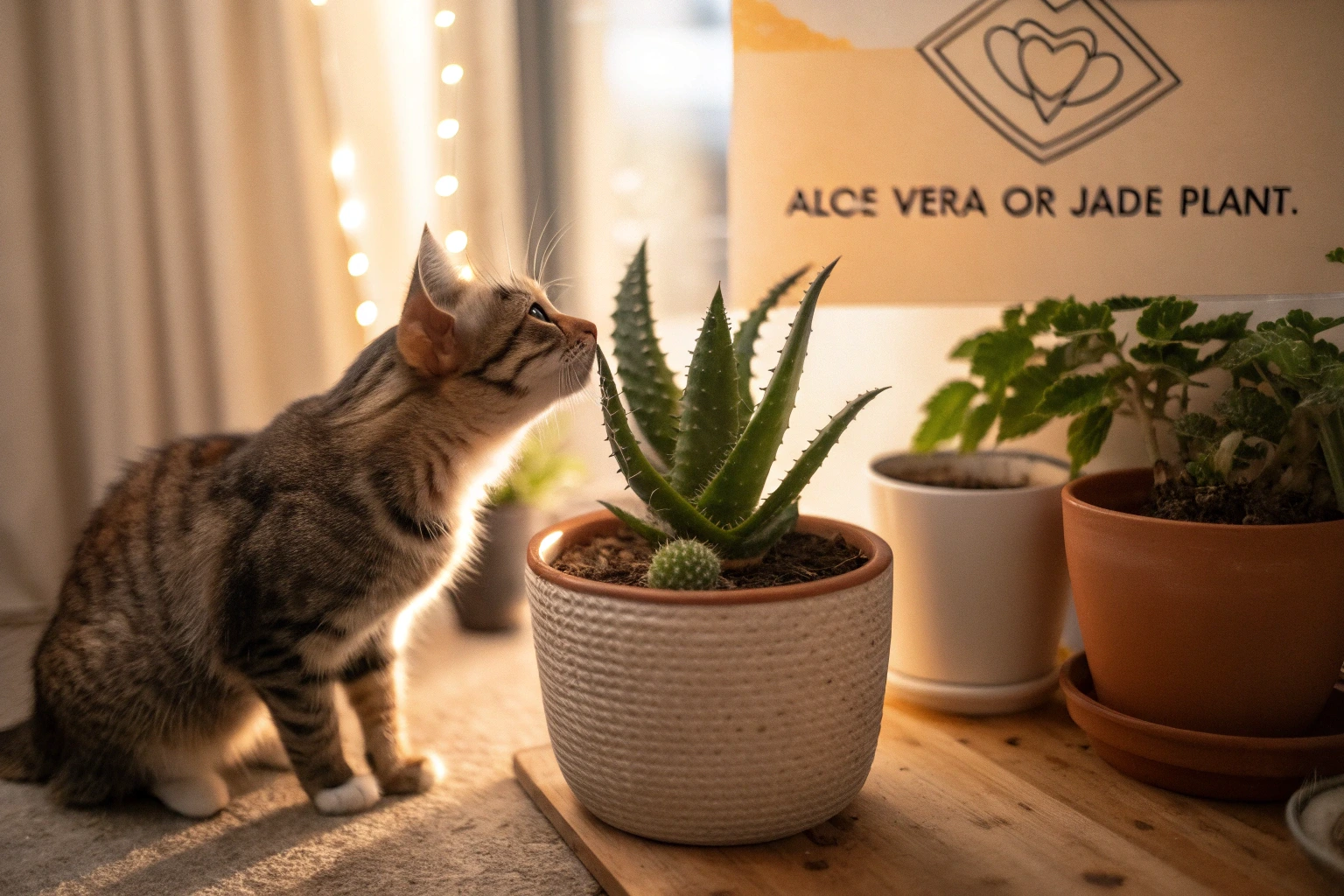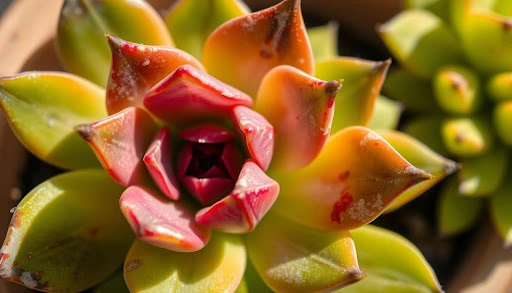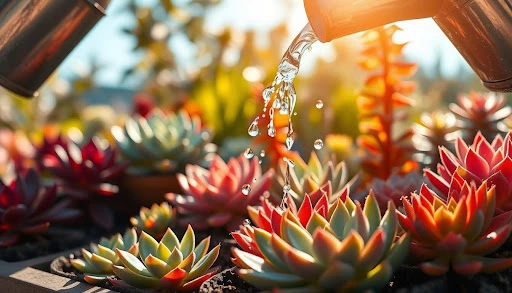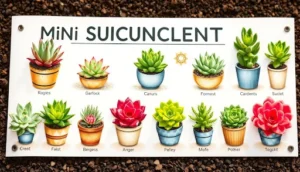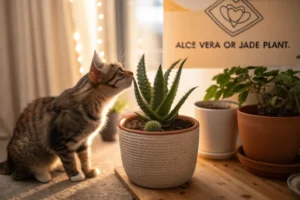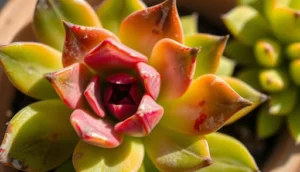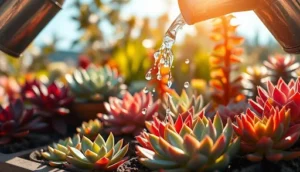Have you ever stared at your beloved succulent collection and wondered, “Am I helping or hurting these little succulents with fertilizer?”
Succulents are like the low-maintenance rockstars of the plant world, but fertilizing can be a bit tricky.
But let’s address the burning question: Is fertilizer bad for succulents? It’s not that bad.
In fact, using the right fertilizer the right way can help your succulents thrive.
But like any good relationship, it’s all about timing, balance, and understanding their needs. Let’s dig into the details.
Can You Use Fertilizer on Succulents?
Absolutely! When done correctly, succulents can benefit from fertilization.
These desert-dwelling plants might seem harsh and self-sufficient.
Still, they thrive with a little nutritional boost during their active growing season.
While they don’t demand as much attention as other plants, the proper fertilization routine can work wonders for their growth, color, and overall health.
Key Insights
1. Succulents Are Not Heavy Feeders
Unlike your typical houseplants that may require regular feeding, succulents have evolved to survive in nutrient-poor environments.
Their ability to store water and nutrients in their leaves means they don’t need constant replenishment.
This leads many plant owners to wonder: Is fertilizer bad for succulents?
While they don’t require frequent feeding, a light application of fertilizer can still provide essential nutrients, mimicking what they’d naturally receive from decaying organic matter or rainwater runoff.
2. Fertilization Should Be Strategic and Minimal
Think of fertilizing succulents as sprinkling just enough seasoning on a dish—it’s about enhancing, not overpowering.
Over-fertilizing can lead to weak, leggy growth and may even harm the plant by burning its roots.
So, is fertilizer bad for succulents? Not necessarily—but only if used correctly. To avoid damage, always dilute the fertilizer to half (or even quarter) strength and apply sparingly.
3. Timing Is Everything
The best time to fertilize succulents is during their active growing season, typically in spring and summer.
During this period, they actively grow new leaves, roots, and sometimes even flowers, which makes them more receptive to nutrients.
In contrast, most succulents enter dormancy in fall and winter, and fertilizing during this time can do more harm than good.

Tip: Keep an eye on your succulents for signs of growth, like new leaves or offsets, as these are indicators that it’s time to give them a little extra love with fertilizer.
By understanding the specific needs of succulents and adopting a strategic approach, you will not only avoid common pitfalls but also help your plants reach their full potential—without overcomplicating the process!
What Type of Fertilizer is Best for Succulents?
Not all fertilizers are created equal, especially for our resilient succulent friends.
Here’s what you need to know:
| Fertilizer Type | NPK Ratio | Best For |
| Balanced Fertilizer | 10-10-10 | General Maintenance |
| Low-Nitrogen Fertilizer | 5-10-10 | Preventing Leggy Growth |
| Specialized Succulent Fertilizer | 3-1-2 | Optimal Succulent Health |
Understanding NPK Ratios for Succulents
Fertilizers are typically labeled with an NPK ratio, which represents the proportion of three key nutrients:
- N (Nitrogen): Promotes leaf and stem growth
- P (Phosphorus): Supports root development and flowering
- K (Potassium): Enhances overall plant health and disease resistance
Detailed Breakdown of Fertilizer Types:
Balanced fertilizer (10-10-10)
Composition: Equal parts nitrogen, phosphorus, and potassium
Pros:
- Provides comprehensive nutrition
- Suitable for general plant maintenance
- It helps maintain overall plant health
Cons:
- It may promote excessive leaf growth
- It can be too intense for succulents’ delicate nutrient needs
Best Used:
- For established, healthy succulents
- During the active growing season
- Sparingly and always diluted
Low-Nitrogen Fertilizer (5-10-10)
Composition: Lower nitrogen, higher phosphorus and potassium
Pros:
- Prevents leggy, weak growth
- Encourages compact plant structure
- Supports root and flower development
Cons:
- Less suitable for succulents needing significant growth
- Requires careful application
Best Used:
- For succulents prone to stretching
- To maintain compact growth
- During the early stages of growth
Specialized Succulent Fertilizer (3-1-2)
Composition: Explicitly tailored for succulents and cacti
Pros:
- Precisely balanced for succulent needs
- Mimics natural nutrient environments
- Prevents over-fertilization
Cons:
- It may be more expensive
- Less readily available
Best Used:
- As a primary fertilization method
- For all types of succulents
- During the active growing season
Fertilizer Selection Criteria:
- Low nitrogen content (crucial!)
- Slow-release formulations
- Organic options preferred
- Specifically designed for succulents or cacti
Red Flags to Avoid:
- High-nitrogen fertilizers
- Fast-release chemical fertilizers
- Generic houseplant fertilizers
- Fertilizers with unknown or unbalanced NPK ratios
Application Tips:
- Always dilute to half or quarter-strength
- Apply during the morning or evening
- Water plants before fertilizing
- Avoid direct contact with leaves
- Stop fertilizing during dormant seasons
Alternative Organic Options:
- Worm castings
- Diluted compost tea
- Fish emulsion (heavily diluted)
- Seaweed extract
Think of fertilizing succulents like seasoning food. A little goes a long way, and too much can ruin the entire dish. The goal is subtle enhancement, not overwhelming transformation.
Caution: Every succulent species is unique.
What works for one might not work perfectly for another.
Observe your plants closely and adjust your fertilization strategy accordingly.
Recommended Brands: Espoma Cactus Fertilizer
By understanding these nuanced fertilizer options, you can provide your succulents with precisely what they need to thrive – without overwhelming their natural resilience.
How Often Should I Fertilize My Succulents?

Timing is key when it comes to fertilizing succulents.
Understanding Succulent Growth Cycles
Active Growing Season (Spring and Summer)
Timing: March to August (Northern Hemisphere)
Physiological Changes:
- Rapid cell division
- New leaf and root growth
- Potential flowering period
- Increased metabolic activity
Fertilization Frequency: Once every 4-6 weeks
- Ideal interval: Every 30-45 days
- Dilute fertilizer to 1/4 to 1/2 strength
- Apply during mid-morning or late afternoon
Dormant Season (Fall and Winter)
Timing: September to February (Northern Hemisphere)
Physiological Characteristics:
- Reduced metabolic activity
- Minimal to no growth
- Water and nutrient conservation
- Preparing for winter survival
Fertilization: Complete Halt
- Zero fertilization
- Reduce watering
- Protect from extreme temperatures
Species-Specific Considerations
Factors Influencing Fertilization Frequency:
- Native habitat
- Specific succulent species
- Indoor vs. outdoor environment
- Local climate conditions
Detailed Fertilization Schedule by Succulent Type:
A. Desert Succulents (Cacti, Echeveria)
- The most strict dormancy period
- Minimal nutrients required
- Fertilize: 3-4 times during active season
- Completely dormant in winter
B. Tropical Succulents (Kalanchoe, Christmas Cactus)
- Less rigid dormancy
- Some continued growth in winter
- Fertilize: 4-5 times during active season
- Reduced but not eliminated winter nutrients
- Potentially extended growing season
- Consistent temperature and light
- Fertilize: Every 6-8 weeks
- Monitor individual plant response
Precise Fertilization Technique
Application Method:
- Dilute fertilizer to 1/4 strength
- Mix with water during regular watering
- Apply to moist soil
- Avoid direct contact with leaves
- Water thoroughly after application
Warning Signs of Incorrect Fertilization:
- Leggy, stretched growth
- Pale or discolored leaves
- Soft, mushy texture
- Lack of compact growth
- Reduced flowering
Environmental Influence Factors
Climate Considerations:
- Tropical regions: More frequent fertilization
- Arid regions: Less frequent, more diluted
- Greenhouse environments: Consistent, moderate fertilization
- Outdoor gardens: Seasonal variation critical
Monitoring and Adaptation
Observation Techniques:
- Track new growth
- Assess leaf color and firmness
- Monitor overall plant vigor
- Adjust fertilization based on individual plant response
Recommended Fertilization Journal:
- Date of application
- Fertilizer type and dilution
- Plant’s response
- Environmental conditions
- Any notable changes
Special Scenarios
Newly Propagated Succulents:
- Wait 4-6 weeks after propagation
- Initial nutrients from the parent plant
- Gradual, minimal fertilization
Stressed or Recovering Plants:
- Halt fertilization
- Focus on proper watering
- Provide optimal growing conditions
- Resume fertilization when fully recovered
Fertilization is an art of subtlety. Think of it as a nutritional whisper, not a shout. Less is always more with succulents.
Seasonal Fertilization Cheat Sheet:
- Spring: Begin light fertilization
- Summer: Peak fertilization period
- Fall: Gradually reduce
- Winter: Complete rest
Caution: These are general guidelines. Always observe your specific plants and adjust accordingly.
Each succulent is unique and may require personalized care.
What Happens If I Over-Fertilize My Succulents?

If you are a succulent lover, you’ve probably heard the saying: “Too much of a good thing can be bad.”
This is truer than anywhere else, especially when fertilizing these resilient little plants.
Let me share what I’ve learned through years of nurturing my succulent collection—and a few painful mistakes.
The Warning Signs Your Succulent is Struggling
When you over-fertilize, your beloved succulents start sending out distress signals.
It’s like they’re trying to tell you, “Hey, slow down with the plant food!”
Leaf Trouble: The First Red Flag Imagine your once-vibrant succulent suddenly looking sick. Here’s what to watch for:
- Yellowing or browning leaves
- Soft, mushy leaf texture
- Unusual stretching or “leggy” growth
Think of it like overfeeding a child – good intentions, disastrous results.
Underground Damage: What You Can’t See Most gardeners don’t realize the real damage happens beneath the soil:
- Salt buildup around roots
- Damaged root systems
- Reduced water absorption
The Real Cost of Over-Fertilizing
Long-term, over-fertilizing can:
- Weaken your plant’s natural defenses
- Stunt growth
- Make succulents more vulnerable to diseases
- Destroy the compact, beautiful shape that makes succulents so attractive
Rescue Mission: Saving Your Over-Fertilized Succulent
Don’t panic. Here’s your step-by-step recovery plan:
Soil Flush Treatment
- Gently run clean water through the pot
- Allow soil to drain completely
- Repeat 2-3 times
- Think of it like detoxing your plant
Emergency Repotting
- Use fresh, well-draining succulent soil
- Carefully remove damaged roots
- Give your plant a fresh start
Pruning and Recovery
- Cut off mushy or discolored parts
- Let the plant rest and recover
- No fertilizer during the healing time
Prevention: Your Best Defense
Fertilizing Dos and Don’ts:
- Dilute fertilizer to 1/4 strength
- Fertilize sparingly (once every 4-6 weeks)
- Only fertilize during the growing season
- Use succulent-specific fertilizers
Less is always more with succulents. They’re desert survivors – they don’t need constant pampering!
Why Trust My Advice?
After years of gardening and talking with succulent experts, I’ve learned that understanding your plants is an art.
Succulents are not like other houseplants. T
hey are unique, and they demand a different approach.
Personal Story: My Biggest Mistake I once killed a beautiful echeveria by thinking, “More nutrients = happier plant.” Spoiler alert: it doesn’t.
That painful lesson taught me everything I’m sharing today.
Your Succulent, Your Journey
Every plant is different. Pay attention to your succulent’s signals. No guide—including this one—can substitute for careful observation and genuine plant love.
Want to become a succulent pro? Start by respecting these fantastic plants’ natural resilience.
Can I Make My Succulent Fertilizer at Home?

Yes, you absolutely can!
DIY succulent fertilizers are a fantastic way to provide your plants with essential nutrients while saving money and reducing environmental impact.
Making your fertilizer is simple, uses ingredients you might already have, and allows you to tailor the nutrient mix to your plants’ needs.
Why Use DIY Fertilizer for Succulents?
Succulents are minimalists—they thrive on a bit of care, but not too much.
Using a DIY fertilizer lets you avoid the risk of over-fertilizing that often comes with store-bought products.
Plus, organic, homemade fertilizers work gently over time, enriching the soil without shocking the plant.
DIY Succulent Fertilizer Recipe
This easy, beginner-friendly recipe provides a balanced nutrient boost without overwhelming your succulents:
Ingredients:
- Compost Tea Provides a natural source of nitrogen, phosphorus, and potassium.
- Water: Helps dilute the nutrients for safe application.
- Optional: Epsom Salt adds magnesium, which can enhance leaf health and color. Use sparingly to avoid nutrient imbalance.

Preparation:
- Combine 1 part compost tea with 1 part water in a container.
- Add a small pinch of Epsom salt if desired, and stir until dissolved.
- Transfer the mixture to a spray bottle or watering can.
How to Use It:
- Apply the fertilizer during the active growing season (spring and summer) when succulents are most responsive.
- Water the soil with the mixture every 4–6 weeks.
- Avoid direct contact with the leaves to prevent potential burns.
How to Tell If Your Succulent Needs Fertilizer
Succulents are resilient, but they will “ask” for nutrients if they’re lacking essential elements. Look out for these signs:
- Stunted Growth: If your plant isn’t growing during its active season (spring or summer), it may need a nutrient boost.
- Pale or Faded Colors: Succulents that lack vibrancy often signal a deficiency in essential minerals like magnesium or potassium.
- Fewer or No Blooms: Flowering succulents, like echeverias, need extra nutrients to produce vibrant blooms. A lack of flowers may mean it’s time for fertilizer.
Benefits of Homemade Fertilizer
- Customizable: Adjust the nutrient content to suit your plant’s needs.
- Gentle: Organic fertilizers are less likely to overwhelm succulents compared to chemical options.
- Eco-Friendly: Uses natural, sustainable materials that benefit the environment.
By monitoring your succulent’s growth and making a simple DIY fertilizer, you can ensure your plants stay healthy, vibrant, and happy without spending a fortune.
Can I Use Organic Fertilizers on Succulents?

Let’s be honest – when I first started growing succulents, I was totally confused about fertilizing.
Should I use chemical fertilizers? Organic options? Wait, can I even fertilize these desert plants?
After years of trial and error (and accidentally killing more than a few succulents), I have learned some game-changing lessons about organic fertilizers that I’m excited to share.
The Truth About Organic Fertilizers and Succulents
Succulents aren’t like your typical houseplants.
They’re basically the camels of the plant world – tough, resilient, and used to surviving with minimal resources.
But that doesn’t mean they can’t benefit from a little nutritional boost.
My Top 3 Organic Fertilizer Superstars
- Compost Tea: The Liquid Gold Most gardeners have no idea how magical compost tea can be. It’s basically a nutrient-packed smoothie for your plants. Think of it like a multivitamin that feeds not just the plant but the entire soil ecosystem.
How I Make My Compost Tea:
- Grab some finished compost
- Steep it in water (like making peculiar tea)
- Strain out the solids
- Dilute before using
Always dilute! These plants aren’t looking for an all-you-can-eat buffet.
- Worm Castings: The Unexpected Hero I know, I know – worm poop sounds gross. But trust me, it’s plant magic. Worm castings are packed with nutrients and beneficial microbes that make your succulents go wild.
Application Method:
- Mix a small amount into your potting soil.
- Use as a top dressing.
- Don’t go overboard – a little goes a long way.
Fish Emulsion: The Stinky Miracle Worker Warning: This stuff smells terrible. But wow, do plants love it?
High in nitrogen and trace minerals, it’s like a protein shake for your succulents.
Always, ALWAYS dilute fish emulsion. Pure fish emulsion will destroy your plants faster than you can say, “what’s that smell?”
The Golden Rules of Organic Fertilization
- Less is more
- Dilution is your friend
- Observe how your plants respond
My Biggest Mistakes (So You Don’t Make Them)
Early in my plant parenting journey, I thought more fertilizer meant happier plants.
Spoiler alert: It doesn’t. I’ve killed more succulents with kindness than anything else.
One memorable disaster involved a beautiful echeveria and an enthusiastic application of undiluted fish emulsion.
Let’s say it didn’t end well for the plant – or my nose.
When to Fertilize
- Spring and early summer are your best bet
- During the active growing season
- Stop fertilizing in the fall and winter
Warning Signs You’ve Over-Fertilized
- Weird, stretched-out growth
- Leaves turning yellow or brown
- Plant looking generally unhappy
My Homemade Organic Fertilizer Blend
Want my secret recipe? Here it is:
- 1 part worm castings
- 1 part compost
- 1/2 part bone meal
- Sprinkle of love (and patience)
Organic fertilizers aren’t a magic solution, but they can help your succulents thrive when used correctly.
It’s about understanding these fantastic plants and giving them precisely what they need – no more, no less.
Remember: Succulents are survivors. They don’t need constant pampering. Think of fertilizing like seasoning food – a little goes a long way.
Benefits of Fertilizing Succulents
Fertilizing succulents strategically can provide surprising benefits despite their reputation as low-maintenance plants.
These desert-adapted beauties might not demand much, but the proper nutrients can work wonders when applied correctly:
Boost Plant Growth
Fertilizer provides essential nutrients that support healthy leaf, stem, and root development.
While succulents don’t grow as rapidly as other plants, a gentle fertilization routine during the growing season can encourage robust growth.
Enhance Color Vibrancy
Many succulents develop stunning hues of green, purple, pink, and blue.
Fertilizing with the right balance of nutrients can amplify these colors, mainly if the plant receives plenty of sunlight.
Improve Overall Plant Health
Nutrients like nitrogen, phosphorus, and potassium enhance a succulent’s resistance to pests, diseases, and environmental stressors.
A healthy, well-fed succulent is more resilient and looks lusher.
Support Flowering
Some succulents, like echeverias and kalanchoes, produce beautiful flowers during their active season.
Fertilizing with phosphorus-rich nutrients before the blooming season can encourage more frequent and vibrant blooms.
Conclusion
Fertilizing succulents isn’t rocket science – it’s about understanding their unique needs.
With the right approach, you will transform your succulents from surviving to thriving.
FAQs
Q: What are the potential risks of over-fertilizing succulents?
Over-fertilizing succulents can lead to soft, mushy leaves caused by water retention, making the plants susceptible to rot. It may also cause unusual elongation of stems, disrupting their compact growth. Additionally, excess nutrients can burn the roots, reducing water absorption and potentially leading to the plant’s death.
Q: When is the best time to fertilize succulents?
Fertilize succulents during their active growing seasons in spring and summer. Avoid fertilizing in fall and winter, as most succulents enter dormancy during this period. Timing fertilization to their natural growth cycles ensures better nutrient absorption and plant health.
Q: How often should I fertilize my succulents?
Succulents typically need fertilization every 2–3 months during their growing seasons. Over-fertilization should be avoided, as succulents require minimal nutrients. Always dilute fertilizer to half-strength to prevent nutrient overload and ensure safe feeding.
Q: How should I fertilize succulents?
Dilute fertilizer to half-strength and mix it with water. Apply during regular watering sessions, ensuring it reaches the soil without directly touching the leaves. Stop fertilizing during fall and winter to respect the plant’s natural dormancy phase.
Q: What should I avoid when fertilizing succulents?
Avoid using regular houseplant fertilizers, as they may overwhelm succulents. Do not fertilize dormant plants, newly repotted succulents, or those under stress. Constantly water the soil before fertilizing to prevent root burn and ensure the fertilizer is suitable for succulents.
Q: Do succulents benefit from being sprayed?
While succulents don’t need regular misting, occasional light spraying can remove dust from leaves and provide minimal moisture in dry conditions. However, avoid spraying during fertilization to prevent leaf burn or nutrient imbalances, as their leaves are susceptible to fertilizers.

